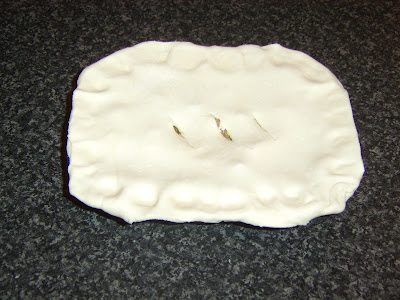
It is rare - if ever - that I prepare any type of recipe which could be classed as
junk food, either to be published on this blog or anywhere else. I have always believed, however, that the BLT is very unfairly treated in being classed as junk food and that, in theory at least, it is and can be a fairly healthy concoction. The idea for this adaptation of the BLT to a higher level came about one night very recently when I was enjoying a gammon steak with pineapple. I was delighted the way this recipe turned out and I hope that you will try it some time soon.
 Preparing the French Fries
Preparing the French FriesI am aware that the way in which I prepare French fries - or
British chips - is fairly time consuming and that not everyone will have the luxury of being able to emulate this method. If time does permit, I would urge that you try them this way, but if not, a more traditional cooking method will of course suffice.
In simple terms, I firstly peel the potatoes and then slice and chop them in to French fry shapes. I then add them to a pan of cold, lightly salted water and put them on to a high heat. When the water starts to boil, I reduce the heat to achieve a gentle simmer and allow the fries to simmer for
five minutes only.
(Tip - Using a wire basket more associated with a deep fryer, as in the image above, allows the parboiled fries to simply be lifted from the hot water rather than drained. This means that they are less likely to break.)
The fries should be lifted from the water, covered and allowed to cool. They should then be placed in a tupperware dish and refrigerated for at least one hour. After this time, they should be very carefully dried with kitchen towel before being fried in moderately hot oil for five minutes. They should again be drained, cooled and refrigerated for at least one hour.
The fries should be fried for the second and final time in slightly hotter oil at the stage below where the bacon has been put on to cook.
 Preparing the BLT
Preparing the BLTIt is important that all of the individual elements for the BLT be prepared in full prior to starting cooking. You will not have a great deal of time between the various stages of this procedure and lack of forward planning could cause significant problems.
Per BLT, you will require:
1 large, soft bread roll (no sugar and salt saturated burger buns!)
2 rashers/slices of bacon
2 leaves of Little Gem or other small lettuce variety
1 slice of beef tomato (approx. 1/2" thick)
1 pineapple ring
1 oz grated cheddar or other hard cheese
2 basil leaves
Freshly ground black pepper

The first step is clearly to cook the bacon. Note that I have used
Ayrshire middle bacon in this instance. This bacon is rolled and sliced, rather than cut in to rashers, though traditional bacon will of course work just as well. I have also on this occasion gently fried the bacon in a dry, non-stick pan. The fat of the bacon will melt on an initially very low heat and no other fat or oil is required. The bacon can of course also be grilled for an even healthier effect.
When the bacon is almost ready, the bread roll should be halved and very lightly toasted under a hot overhead grill.

The first stage of assembling this cheesey, pineappley BLT is to place the lettuce leaves on the bottom of the bun. The bacon should be gently shaken to remove as much of the fat as possible before being laid on top of the lettuce. The slice of tomato goes on next, to effectively complete what would be a traditional BLT.

The pineapple ring should then be placed on top of the tomato. Note that this pineapple ring did come from a can but was canned in pineapple juice and not syrup. The basil leaves are quickly torn and scattered over the pineapple.

The cheese is the final addition before the bottom half of the BLT goes back under the hot grill. Pressing the cheese down lightly when it is added will help to prevent it slipping off as it is put under the grill. When the cheese begins to bubble, the roll should be plated, given a final seasoning with black pepper only (the bacon will provide sufficient saltiness) and served with the French fries, either open as at the top of this post or closed as below.


























